Indian Sickle Cell Disease Research: A Scientometric Assessment of Publications Output During 2008-17
Gupta BM1 and Ritu Gupta2*
1Formerly with National Institute of Science Technology and Development Studies, New Delhi, India
2Formerly with S.V. University, Tirupathi, India
Submission: August 03, 2018; Published: August 31, 2018
*Corresponding author: Ritu Gupta, Formerly with S.V. University, Tirupathi, India.
How to cite this article: Ritu Gupta, Gupta BM. Indian Sickle Cell Disease Research: A Scientometric Assessment of Publications Output During 2008- 17. Open Acc Blood Res Trans J. 2018; 2(4): 555592. DOI: 10.19080/OABTJ.2018.02.555592
Abstract
The present study examined 436 Indian publications in Sickle Cell disease, as indexed in Scopus database during 2008-17, with a view to understand their growth rate, global share, citation impact, international collaborative papers share, distribution of publications by broad subjects, productivity and citation profile of top organizations and authors, preferred media of communication and bibliographic characteristics of high cited papers. The Indian publications registered an annual average growth rate of 9.97%, global publication share of 3.80%, international collaborative publication share of 3.80% and citation impact per paper of 10.90. Among 123 countries participating in global Sickle Cell disease research, the top 10 most productive countries global share individually ranged from 2.12% to 46.89%, with USA contributing the largest share of 46.89%, followed by U.K. (9.58%), France (7.23%), Brazil (5.95%), etc. 87.32%. More than 100% share of the cumulative global publication and citation share comes from top 10 countries during 2008-17. Medicine, among seven broad subjects, contributed the largest publications share of 74.31%, followed by biochemistry, genetics & molecular biology (16.51%), pharmacology, toxicology & pharmaceutics (10.55%) and immunology & microbiology (2.29) during 2008-17. Among various 243 organizations and 594 authors contributing to Indian Sickle Cell disease research, the 10 most productive global organizations and authors together contributed 42.89% and 41.28% respectively as their share of global publication output and more than 100% and 23.71% respectively as their share of global citation output during 2008-17. Amongst 423 journal papers (in 192 journals) in Indian Sickle Cell disease research, the top 15 most productive journals contributed 37.59% share of total journal publication output during 2008-17.
Keywords: Sickle cell disease, Indian publications, Scientometrics, Bibliometrics
Abbrevations: SCD: Sickle Cell Disease; WHO: World Health Organization; UN: United Nations
Introduction
Sickle cell disease (SCD) (known also as sickle cell anemia or sickle cell disorder), is an inherited blood disorder and also referred to as a haemoglobinopathy. It is caused by a single misspelling in the DNA instructions for hemoglobin, a protein vital for carrying oxygen in the blood. The disease damages and changes the shape of red blood cells (RBCs). The change in shape is a response to cell deoxygenation. When the oxygen uptake of the cell is low, cells change their shape from a healthy round disk to a crescent, holly leaf or other similarly distorted shape. This shape distortion is referred to as sickling. Hence, the disease is known as sickle cell disease. The sickled cells are rigid, less malleable and stickier than normal, healthy cells, so they consequently may stick to each other and obstruct blood vessels or are not sufficiently malleable and obstruct blood vessels. This obstruction causes harsh and painful complications. Often, these red blood cells will also break down and cause anemia, so we also refer to the disease as sickle cell anemia. Consequent to the breakdown of red blood cells (haemolysis), cell survival may be reduced to as little as twenty days, whereas a normal red blood cell will last anywhere from 110-120 days [1-2]. As a result of this mutation, individuals with SCD experience lifelong complications including anemia, infections, stroke, tissue damage, organ failure, intense painful episodes, and premature death. These debilitating symptoms and the complex treatment needs of people living with SCD often limit their education, career opportunities, and quality of life [2].
Following are the most common types of SCD:
(i) HbSS: People who have this form of SCD inherit two sickle cell genes (“S”), one from each parent. This is commonly called sickle cell anemia and is usually the most severe form of the disease;
(ii) HbSC: People who have this form of SCD inherit a sickle cell gene (“S”) from one parent and from the other parent a gene for an abnormal hemoglobin called “C”. Hemoglobin is a protein that allows red blood cells to carry oxygen to all parts of the body. This is usually a milder form of SCD and
(iii) HbS beta thalassemia: People who have this form of SCD inherit one sickle cell gene (“S”) from one parent and one gene for beta thalassemia, another type of anemia, from the other parent. There are two types of beta thalassemia: “0” and “+”. Those with HbS beta 0-thalassemia usually have a severe form of SCD. People with HbS beta +-thalassemia tend to have a milder form of SCD. There also are a few rare types of SCD: HbSD, HbSE and HbSO. People who have these forms of SCD inherit one sickle cell gene (“S”) and one gene from an abnormal type of hemoglobin (“D”, “E”, or “O”). Hemoglobin is a protein that allows red blood cells to carry oxygen to all parts of the body. The severity of these rarer types of SCD varies [3].
Organizations such as the World Health Organization (WHO) and United Nations (UN) have recognized SCD as a global health issue. In 2006, the World Health Assembly passed a resolution recognizing SCD as a public health priority and called on countries to tackle the disease. This resolution was also adopted by the United Nations in 2009. In countries with poor public health systems and high levels of poverty, SCD remains a major killer of infants and children, similar to other diseases like malaria and HIV/AIDS. In resource-poor countries, 90 percent of children with SCD do not survive to adulthood. And the problem is growing; by 2050 the number of people with SCD is expected to increase by about 30 percent globally. Some middle-income countries are making advancements in both early diagnosis and management of SCD [2].
Globally it is estimated that, SCD occurs in approximately 300,000 births annually. Prevalence of sickle cell trait varies greatly between different regions but reaches levels as high as 40 percent in some areas of sub-Saharan Africa, eastern Saudi Arabia, and central India. In resource-poor countries more than 90 percent of children with SCD do not survive to adulthood. SCD is most prevalent in malaria endemic parts of the world, primarily Africa, the Middle East and South Asia. SCD has a high prevalence in India, especially in the central and western regions. Approximately 20 percent of children with SCD die by the age of two [2].
In India, the National Guideline on Hemoglobinopathies was released by the National Health Mission in 2017. This guideline aims at improving the treatment and management of patients with SCD by providing free blood transfusions, iron chelation medicines and other interventions in all government hospitals and state-run health centers. Such policies are a positive step for improving the life quality of patients. The Disability Act 2016 also provides legal protection for SCD patients including access to education and employment [4].
Literature review
There is no specific bibliometric study on Sickle Cell disease output both at national and international level. However, there are few quantitative studies focusing on overall blood diseases. Among such studies, Daneshmand, Forouzandeh, Azadi and Cheraghzadeh Dezfuli [5] examined quantitative and qualitative evaluation of hematological research output in five Islamic countries; Iran, Turkey, Malaysia, Saudi Arabia and Egypt; which have the most scientific productions from 1996-2013. Gupta [6] analyzed the heredity blood disorders research output, using Scopus database during 2002-11 on different parameters including the global publications share and citation quality of top 10 leading countries, India’s growth, citation impact, share of international collaborative papers, contribution of major collaborative partner countries, contribution of various subject fields and by type of heredity blood disorder, pattern of research communication in most productive journals, productivity and citation profile of top Indian institutions and authors and characteristics of high cited papers. Bansal, Bansal and Gupta [7] examined the Indian research output consisting of 717 publications on “iron deficiency anemia” as covered in Scopus database during 2006-15. Different parameters including publication growth, citation impact, share of international collaborative papers and identification of major international collaborative partners, global rank and share of India amongst the top 20 most productive countries, productivity and citation impact of leading Indian institutes and authors, medium of communication in most productive journals.
Objectives
Based on publications covered and indexed in Scopus database, the present study analyses the Indian Sickle Cell disease research during 2008-17. In particular, the study analyses the growth rate in Indian publications, its global and international collaborative publication share and citation impact per paper; its broad distribution of output by broad subject areas; its leading organizations and authors, in terms of publication output and citation impact and its leading medium of communication, particularly the most productive journals.
Methodology
Several quantitative and qualitative bibiometric indicators have been used in this study to measure the performance of Indian Sickle Cell disease research. The basic publication data for the present study was retrieved and downloaded from the Scopus database (http://www.scopus.com) for 10 years during 2008-17. For retrieving publication data from the Scopus database, the authors have used the Keyword “Sickle Cell*“in “Keyword” tag or ‘’Article Title’’ tag and further restricting the search to the period 2008-17 in “date range tag” for searching the global publication data on Sickle Cell research and this becomes the main search string. When the main search string with restricted to individual top 10 most productive country names (including India) in “country tag”, the publication data on the individual country in Sickle Cell research obtained. The Indian search string is further refined, as provided in Scopus database, by restricting to “subject area tag”, “country tag”, “source title tag”, “journal title name” and “affiliation tag”, to get information on the distribution of publications by subject, collaborating countries, author-wise, organization-wise and journal-wise, etc. For citation data, citations to publications were also collected from the date of publication till 1 June 2018.
(KEY(Sickle cell*) OR TITLE(Sickle cell*)) AND PUBYEAR > 2007 AND PUBYEAR < 2018 AND ( LIMIT-TO ( AFFILCOUNTRY,”India” ) )
Analysis
The world has published 11487 and 436 global and Indian publications on Sickle Cell disease research in 10 years during 2008-17, which increased from 988 to 1198 (global) and 21 to 31 (Indian) publications in the year 2008 to the year 2017, registering annual average growth rates of 2.38% and 9.97%. The cumulative growth of global and Indian publications on Sickle Cell disease research increased from 5239 to 6248 and 168 to 268 publications from 2008-12 to 2013-17, witnessing a growth rate of 19.26% and 59.52%%. The global publication share of Indian output was 3.80% during 2008-17, which increased from 3.21% to 4.29% from 2008-12 to 2013-17. The average citation per publication (CPP) registered by global and Indian publications on Sickle Cell disease research were 12.48 and 10.90 during 2008-17, which decreased from 19.52 to 6.58 in global publications and increased from 4.88 to 14.68 CPP in Indian publications from 2008-12 to 2013-17 (Table 1). Of the total Indian publications, 68.81% (300) appeared as articles, 13.07% (57) as reviews, 10.09 (44) as letters, 2.98% (13) as conference papers, 1.83% (8) as editorials, 1.61% (7) as notes, 1.38% (6) as book chapters and 0.23% (1) as short survey.
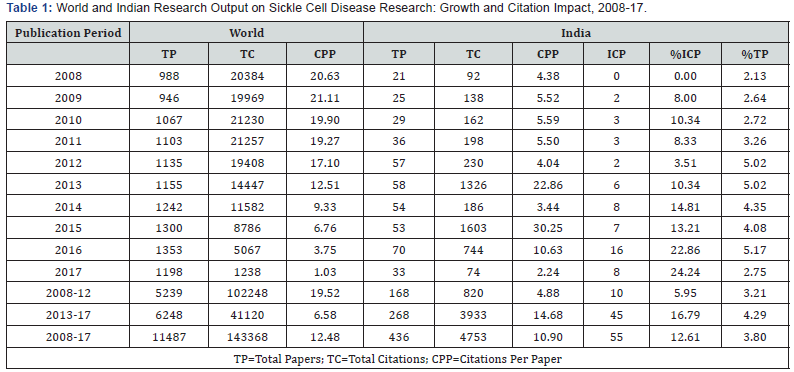
Global publication share & citation impact of top 10 most productive countries
The global Sickle Cell disease research output originated in 123 countries during 2008-17, of which 47 countries contributed 1-10 papers each, 41 countries 11-50 papers each, 16 countries 51-100 papers each, 17 countries 101-500 papers each and 2 countries 1100-5386 papers each during 2008-17. Table 2 lists the output of top 10 most productive countries in Sickle Cell disease research during 2008-17. The cumulative publication and citation share of 10 most productive countries in Sickle Cell disease research was 87.32% and more than 100% of the world publication and citations output during 2008-17. Individually, the global publication share of these 10 countries varied from 2.12% to 46.89% during 2008-17, with highest publication share (46.89%) coming from USA, followed by U.K. (9.58%), France (7.23%), Brazil (5.95%) and other 6 countries from 2.12% to 3.80% during 2008-17.The global publication share showed increase in USA, Brazil, India, Italy and Canada (from 0.14% to 3.53%), as against decrease in U.K., France, Nigeria, Germany and Netherlands (from 0.13% to 0.77%). Five out of 10 countries have scored relative citation index more than the average of 1.58: Germany (2.70), Netherlands (2.27), Canada (2.25), Italy (1.85) and U.K. (1.60) during 2008-17.
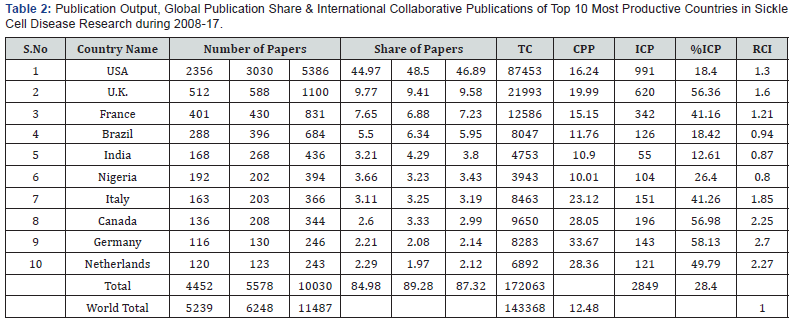
International collaboration
The share of international collaborative papers in India’s research output in Sickle Cell disease output was 12.61% during 2008-17, which increased from 5.95% during 2008-12 to 16.79% during 2003-17. USA tops the list with 52.73% share in India’s international collaborative papers, followed by Saudi Arabia (24.45%), U.K. (23.64%), Jamaica and Singapore (14.55% each), Germany and Malaysia (12.73% each), Canada, Italy and Spain (10.91% each) during 2008-17. The share of international collaborative papers increased in 9 countries (from 1.11% to 18.89%), but decreased in U.K. by 7.78% from 2008-12 to 2013- 17 (Table 3).
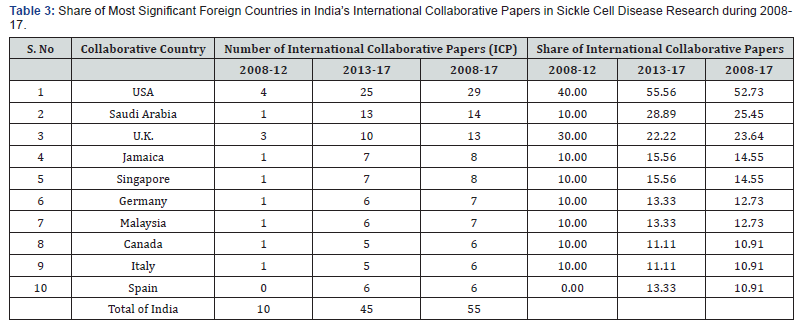
Subject-wise distribution of research output
As per the Scopus database classification, the Indian Sickle Cell disease research output is distributed across four sub-fields during 2008-17. Among sub-fields, medicine registered the highest publications share (74.31%), followed by biochemistry, genetics & molecular biology (16.51%), pharmacology, toxicology & pharmaceutics (10.55%) and immunology & microbiology (2.29) during 2008-17. The publication activity, as seen through activity index from 2008-12 to 2013-17, witnessed decrease in medicine (from 105.73 to 96.41), biochemistry, genetics & molecular biology (from 104.53 to 97.16) and immunology & microbiology (from 129.76 to 81.340) as against increase in pharmacology, toxicology & pharmaceutics (from 78.99 to 113.17) from 2008-12 to 2013-17. Medicine registered the highest citation per paper of 13.87 among four subjects, followed by biochemistry, genetics & molecular biology (5.38), pharmacology, toxicology & pharmaceutics (3.04) and immunology & microbiology (3.0) during 2008-17 (Table 4).

Distribution of papers by population age groups
On classifying Indian publications on Sickle Cell disease research, it was observed that the largest share of papers were devoted to Children’s (34.63%), followed by adolescents (26.15%), adults (9.63%) and aged (7.34%) during 2008- 17. The share of papers decreased in case of children’s (from 36.100% to 33.21%) and adolescents (from 27.38% to 25.37%), as against increase in adults (from 7.14% to 11.19%) and aged (From 4.76% to 8.96%) from 2008-12 to 2013-17 (Table 5).

Significant keywords
Around 45 significant keywords have been identified from the literature, which point to possible trends in Indian Sickle Cell disease research. These keywords are listed in Table 6 in the decreasing order of the frequency of occurrence during 2007-16.
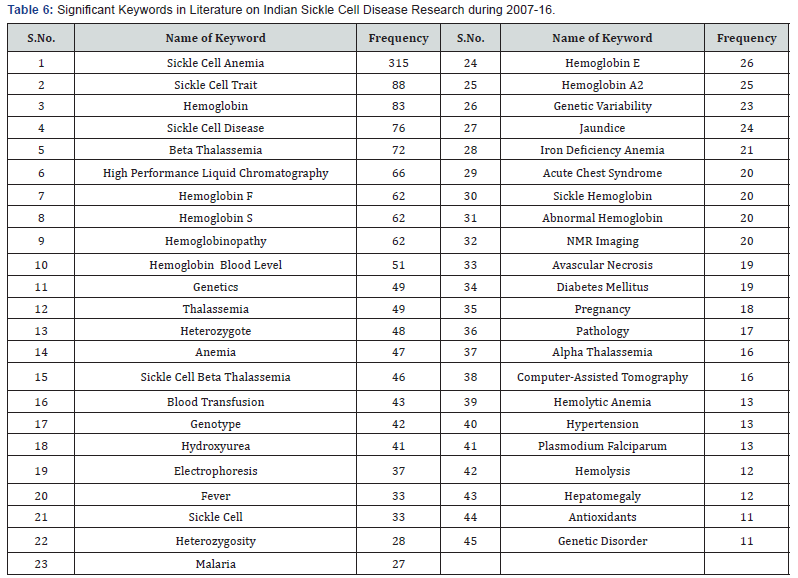
Profile of top 10 most productive organizations
243 organizations participated in Indian Sickle Cell disease research, of which 226 organizations contributed 1-5 papers each, 7 organizations 6-10 papers each, 6 organizations 11- 20 papers each, 3 organizations 21-30 papers each and 1 organization 31 papers. The productivity of 10 most productive organizations in Indian Sickle Cell disease research varied from 11 to 31 publications and together contributed 42.89% (187 publications) publication share and more than 100% (5287) citation share to its cumulative publications output during 2008-17. The scientometric profile of these 10 organizations is presented in Table 7.
a) Four organizations have registered higher publications output than the group average of 18.7: Institute of Haematology, Mumbai (31 papers), Government Medical College, Nagpur (29 papers), All India Institute of Medical Sciences, New Delhi (28 papers) and Pt. J.N.M. Medical College, Raipur (22 papers) during 2008-17.
b) Two organizations have registered more than the average citation per publication (28.27) Postgraduate Institute of Medical Education & Research, Chandigarh (183.17) and All India Institute of Medical Sciences, New Delhi (81.43) during 2008-17.
c) Three organizations have achieved more than the average share of international collaborative publications (14.40%): Postgraduate Institute of Medical Education & Research, Chandigarh (50.0%), All India Institute of Medical Sciences, New Delhi (35.71%) and Pt. J.N.M.Medical College, Raipur (27.27%) during 2008-17.
d) Two organizations have registered the relative citation index more than average (2.59): Postgraduate Institute of Medical Education & Research, Chandigarh (16.80) and All India Institute of Medical Sciences, New Delhi (7.47) during 2008-17.
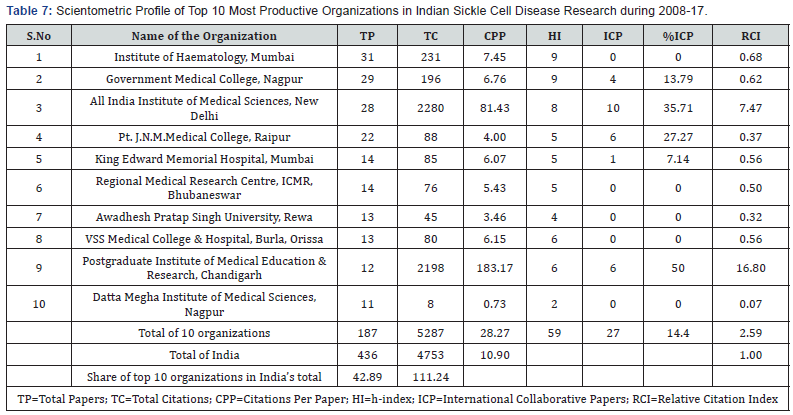
Profile of top 10 most productive authors
594 authors participated in Indian Sickle Cell disease research, of which 518 authors contributed 1-5 papers each, 59 authors 6-10 papers each, 16 authors 11-20 papers each and 1 author 27 papers. The productivity of 15 most productive authors in Indian Sickle Cell disease research varied from 11 to 34 publications and together contributed 41.28% (180 publications) publication share and 23.71% (1127) citation share to its cumulative publications output during 2008-17. The scientometric profile of these 10 authors is presented in Table 8.
a) Three authors have registered higher publications output than the group average of 18.0: R.B. Colatz (34 papers), K. Ghosh (29 papers) and P.K. Patra (24 papers) during 2008-17.
b) Six authors receiving comparatively higher average citation per publication were: D. Jain (10.0), A.H. Nadkarni (8.36), D.K. Patel (7.42), R.B. Colatz (7.41) and K. Ghosh (7.38) during 2008-17.
c) Two authors have achieved more than the average share of international collaborative publications (7.22) of all authors: P.K. Patra (29.17%) and D. Jain (11.76%) during 2008-17.
d) Five authors receiving comparatively higher relative citation index: D. Jain (0.92), A.H. Nadkarni (0.77), D.K. Patel, R.B. Colatz and K. Ghosh during 2008-17.
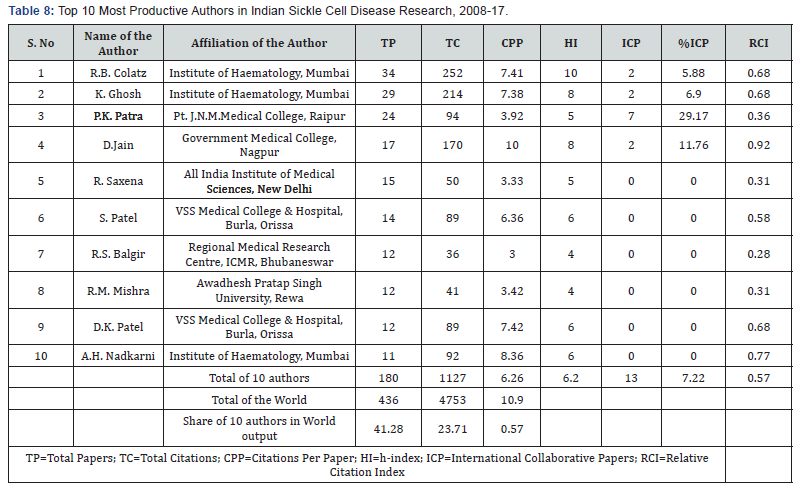
Medium of communication
192 journals participated in 423 journal papers in Indian Sickle Cell disease research, of which 177 journals contributed 1-5 papers each, 10 journals 6-10 papers each, 4 journals 11-20 papers each, and 1 journal 24 papers. The 15 most productive journals in Indian Sickle Cell disease research contributed from 6 to 24 papers and together contributed 37.59% share (159 papers) to the Indian journal publication output during 2008-17. The publication share of these top 15 most productive journals increased from 34.13% to 39.84% from 2008-12 to 2013-17. The most productive journal (with 24 papers) was Journal of Clinical & Diagnostic Research, followed by Indian Journal of Pediatrics (19 papers), Hemoglobin (16 papers), Indian Journal of Hematology & Blood Transfusion (14 papers), Indian Journal of Medical Research (11 papers), Indian Journal of Human Genetics and Indian Journal of Pharma & Bio Sciences (9 papers each), etc. during 2008-17 (Table 9).
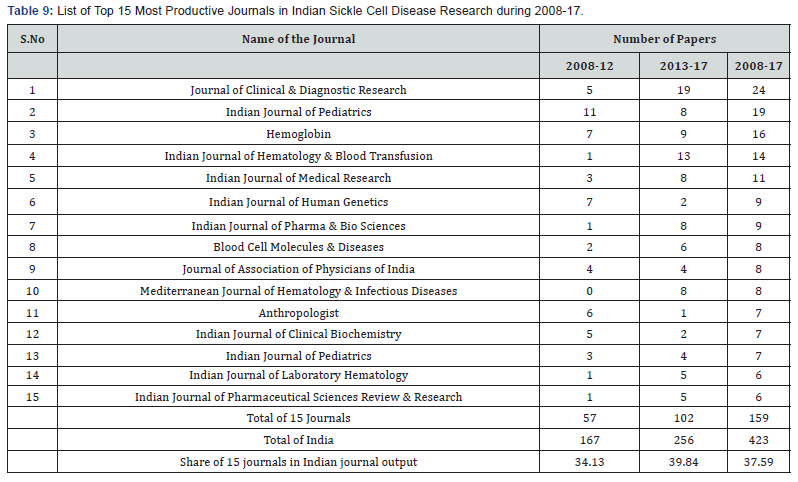
Summary
436 Indian publications on Sickle Cell disease research were published during 2008-17, as indexed in Scopus database, constituting 3.80% share of global publications (11487). The global publication share of Indian output increased from 3.21% to 4.29% from 2008-12 to 2013-17. The Indian publications increased from 21 to 33 from the year 2008 to the year 2017, registering 9.97% growth per annum. Their cumulative Indian publication output on Sickle Cell disease research increased from 168 to 268, witnessing a growth of 59.51% from 2008-12 to 2013-17. The citation impact per paper of Indian publications in Sickle Cell disease was averaged to 10.90 during 2008-17, however, increasing from 4.88 during 2008-12 to 14.68 during 2013-17. The international collaborative papers share in India’s research output on Sickle Cell disease output was 12.61% during 2008-17, which increased from 5.95% during 2008-12 to 16.79% during 2003-17. USA tops the list among international collaborative partners of India with 52.73% share, followed by Saudi Arabia (24.45%), U.K. (23.64%), Jamaica and Singapore (14.55% each), Germany and Malaysia (12.73% each), Canada, Italy and Spain (10.91% each) during 2008-17. The share of international collaborative papers increase in all countries (from 1.11% to 18.89%), except that of U.K., where it decreased by 7.78% from 2008-12 to 2013-17.
About 123 countries participated in global Sickle Cell disease research output, of which the top 10 countries individually contributed global publication from 2.12% to 46.89% during 2008-17 and together contributed 87.32% share and more than 100% share of the world publication and citations output during 2008-17. Among top 10 countries, USA contributed the largest global publication share of 46.89%, followed by U.K. (9.58%), France (7.23%), Brazil (5.95%) and other 6 countries from 2.12% to 3.80% during 2008-17. The global publication share showed increase in USA, Brazil, India, Italy and Canada (from 0.14% to 3.53%), as against decrease in U.K., France, Nigeria, Germany and Netherlands (from 0.13% to 0.77%). Five out of 10 countries have scored relative citation index more than the average of 1.58: Germany (2.70), Netherlands (2.27), Canada (2.25), Italy (1.85) and U.K. (1.60) during 2008-17.
Medicine, contributed the largest publications share of 74.31% in Indian Sickle Cell disease research, followed by biochemistry, genetics & molecular biology (16.51%), pharmacology, toxicology & pharmaceutics (10.55%) and immunology & microbiology (2.29) during 2008-17. As per the Scopus database classification, the Indian Sickle Cell disease research output is distributed across sfour sub-fields during 2008-17. The publication activity showed decrease in medicine, biochemistry, genetics & molecular biology and immunology & microbiology, as against increase in pharmacology, toxicology & pharmaceutics from 2008-12 to 2013-17. Among four subjects, medicine registered the highest citation per paper of 13.87 among four subjects, followed by biochemistry, genetics & molecular biology (5.38), pharmacology, toxicology & pharmaceutics (3.04) and immunology & microbiology (3.0) during 2008- 17. Children’s, among population age group, become the main focus of Sickle Cell disease research and accounts for highest publication share of 34.63% during 2008-17, followed by adolescents (26.15%), adults (9.63%) and aged (7.34%) during 2008-17. The share of papers decreased in children’s (from 36.90% to 33.21%) and adolescents (from 27.38% to 25.37%), as against increase in adults (from 7.14% to 11.19%) and aged (from 4.76% to 8.96%) from 2008-12 to 2013-17.
Amongst 243 organizations and 594 authors contributing to Indian Sickle Cell disease research, the 10 most productive global organizations and authors together contributed 42.89% and 41.28% respectively as their share of global publication output and more than 100% and 23.71% respectively as their share of global citation output during 2008-17. The leading organizations in research productivity were: Institute of Haematology, Mumbai (31 papers), Government Medical College, Nagpur (29 papers), All India Institute of Medical Sciences, New Delhi (28 papers) and Pt. J.N.M. Medical College, Raipur (22 papers) during 2008- 17. The leading organizations in terms of citation impact per paper were: Postgraduate Institute of Medical Education & Research, Chandigarh (183.17) and All India Institute of Medical Sciences, New Delhi (81.43) during 2008-17.
Journal of Clinical & Diagnostic Research was the most productive journal (with 24 papers) in Indian Sickle Cell disease research output, followed by Indian Journal of Pediatrics (19 papers), Hemoglobin (16 papers), Indian Journal of Hematology & Blood Transfusion (14 papers), Indian Journal of Medical Research (11 papers), Indian Journal of Human Genetics and Indian Journal of Pharma & Bio Sciences (9 papers each), etc. during 2008-17. Among the 423 journal papers (in 192 journals) in Sickle Cell disease research, the top 15 most productive journals contributed 37.59% share of total journal publication output during 2008-17, which increased from 34.13% to 39.84% from 2008-12 to 2013-17.
Conclusion
Conclude that there is enormous opportunity to improve the state of present SCD by taking actions to address unmet needs. There is need for us to address existing disparities by increasing access to diagnostic and therapeutic interventions and providing comprehensive care and appropriate support services to people living with SCD. Emerging therapies and promising new insights in the treatment of SCD represent a significant step toward improving outcomes and reducing the treatment burden for affected children and adults.
Alleviating the pain and suffering caused by this disease, as well as the socioeconomic costs, is entirely within our grasp. Although conquering SCD is doable, it requires a well-orchestrated plan and a coordinated effort from a range of partners including government agencies, patient advocacy organizations, health care providers, public health organizations, researchers, foundations, pharmaceutical and biotech companies, and other stakeholders.
In an effort to advance a forward-looking and comprehensive agenda that will make a significant difference, a group of SCD researchers, clinicians, individuals with the disease and policymakers have come together to develop an organized approach to improving outcomes for people with SCD. From these meetings, four priority areas were identified- Access to Care, Training and Professional Education, Research and Clinical Trials, and Global Issues Related to SCD. Such steps will help the global collective efforts toward ultimately advancing SCD care, early diagnosis, treatment and research.
References
- AlJuburi G (2015) Sickle Cells and the burden of disease in England. Imperial College, London, UK.
- (2016) The American Society of Hematology. State of Sickle Cell Disease: 2016 Report. USA.
- Facts about Sickle Cell Disease. 9 August 2017. https://www.cdc.gov/ ncbddd/sicklecell/facts.html)(Accessed on 20 July 2018)
- Namitha Kumar. World Sickle Cell Day. 18 June 2018. www:///C:/ Users/river2/Desktop/New%20Papers%20being%20copleted/ World%20Sickle%20Cell%20Day.html) (Accessed on 20 July 2018).
- Daneshmand AR, Forouzandeh H, Azadi, M, Cheraghzadeh DS (2015) A bibliometric analysis of haematological research productivity among five Islamic countries during 1996 to 2013 (a 17 years period). Iranian Journal of Blood and Cancer7(2): 67-74.
- Gupta BM (2012) Heredity Blood Disorders (HBD): A Scientometric Analysis of Publications Output from India during 2002-2011. J Blood Disorders Transf 3: 126.
- Bansal J, Bansal, Madhu, Gupta BM (2018) Iron Deficiency Anemia: A Scientometric Analysis of Indian Research Output during 2006-15. International Journal of Library Information Network and Knowledge 3(1): 27-41.






























